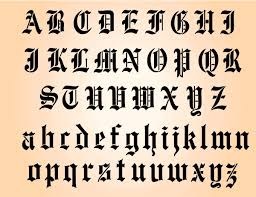|
|
| |
|
|
| |
|
|
|
|
| |
 |
| Alphabet written in
old English. |
Alphabet
The modern English alphabet is a Latin alphabet
consisting of 26 letters, each having an upper- and
lower-case form. It originated around the 7th century
from Latin script. Since then, letters have been added
or removed to give the current Modern English alphabet
of 26 letters with no diacritics, diagraphs, and special
characters. The word alphabet is a compound of the first
two letters of the Greek alphabet, alpha and beta.
A aB bC cD dE eF fG gH hI iJ jK kL lM mN nO oP pQ qR rS
sT tU uV vW wX xY yZ z
The exact shape of printed letters varies depending on
the typeface (and font), and the standard printed form
may differ significantly from the shape of handwritten
letters (which varies between individuals), and cursive
especially. |
|
Letter names
The names of the letters are sometimes spelled out. Some
compound words (e.g., tee-shirt, deejay, emcee, okay,
etc.), derived forms (e.g., exed out, effing, to eff and
blind, aitchless, etc.) and objects named after letters
(e.g., em in printing and wye in railroading) may be
written with the letter names. The spellings listed
below are from the Oxford English Dictionary. Plurals of
consonant names are formed by adding -s (e.g., bees, efs,
ems) or -es in the cases of aitch, ess, and ex (i.e.,
aitches, esses, exes). Plurals of vowel names add -es
(i.e., aes, ees, ies, oes, ues), but these are rare.
Most commonly, the letter (generally in capitalized
form) and not its name is used, in which case plural
just adds -s. |
|
Phonology
The letters A, E, I, O, and U are considered vowel
letters, since (except when silent) they represent
vowels, although I and U represent consonants in words
such as "onion" and "quail" respectively.
The letter Y sometimes represents a consonant (as in
"young") and sometimes a vowel (as in "myth"). Very
rarely, W may represent a vowel (as in "cwm")—a Welsh
loanword.
The consonant sounds represented by the letters W and Y
in English (/w/ and /j/ as in yes /jɛs/ and went /wɛnt/)
are referred to as semi-vowels (or glides) by linguists,
however this is a description that applies to the sounds
represented by the letters and not to the letters
themselves.
The remaining letters are considered consonant letters,
since when not silent they generally represent
consonants. |
|
Old English
The English language itself was first written in the
Anglo-Saxon futhorc runic alphabet, in use from the 5th
century. This alphabet was brought to what is now
England, along with the proto-form of the language
itself, by Anglo-Saxon settlers. Very few examples of
this form of written Old English have survived, mostly
as short inscriptions or fragments. |
|
|
|
|
|
|
|
|
|
|
|
|
|
|
|
|
|
|
Search Fun Easy English |
|
|
|
|
|
|
|
|
|
|
|
|
|
|
|
About
Contact
Copyright
Resources
Site Map |